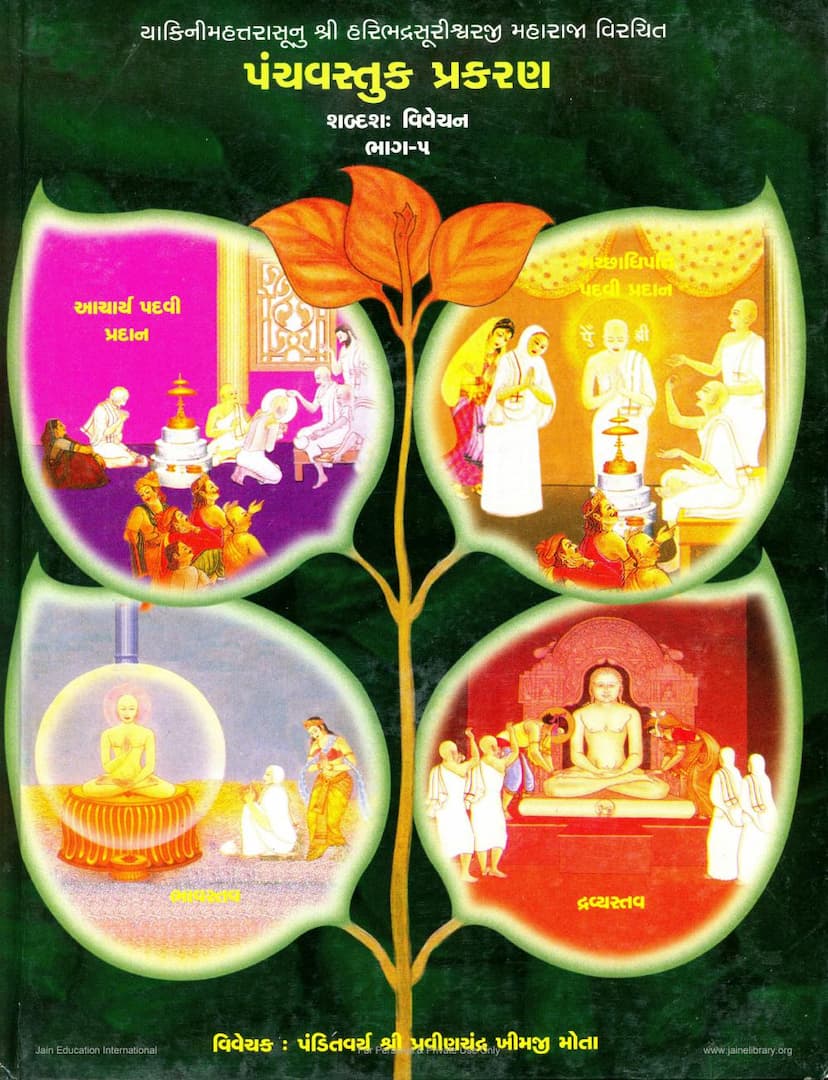Panchvastuk Prakaran Part 05
Added to library: September 2, 2025

Summary
Based on the provided text, here's a comprehensive summary of "Panchvastuk Prakaran Part 05" by Pravinchandra Khimji Mota, focusing on the content related to the "Anuyogaganuanugna" section:
Overall Context:
This volume, "Panchvastuk Prakaran Shaddhash Vivechan, Bhag 5," is a detailed commentary on the fifth part of the "Panchvastuk Prakaran," a Jain text composed by the revered Acharya Shri Haribhadra Suri. The commentary is authored by Pandit Var P. Shri Pravinchandra Khimji Mota. The publication is supported by various Jain scholars and institutions, including Gitarth Ganga.
Core Subject Matter (Anuyogaganuanugna Section):
This specific volume, particularly focusing on the fourth section of the "Panchvastuk Granth" titled "Anuyogaganuanugna Vastuk," delves into the critical aspects of spiritual progression within the Jain tradition, specifically concerning the qualifications and responsibilities associated with the Acharya (spiritual leader) and Gachhadhipati (head of a monastic order) positions. It also touches upon the nature of Stavparigyna (praise and worship), differentiating between material (dravya) and spiritual (bhava) forms.
Key Themes and Concepts Discussed in this Volume (Anuyogaganuanugna):
The commentary elaborates on the original verses (Gathas) of Acharya Haribhadra Suri, offering a meticulous, word-by-word analysis. The primary focus of this volume is on Gatha 933 to Gatha 1365, which falls under the "Anuyogaganuanugna" (अनुयोग-गणानुज्ञा) section.
The "Anuyogaganuanugna" section is primarily divided into two main parts:
-
Anuyoguanugna Dwar (Dwar 1): This part discusses the qualifications and procedures related to the Anuyog (a specific branch of Jain scriptural study and teaching) and the Anugna (permission or authorization) to impart it.
- Qualifications for Acharya: The text emphasizes that only those monks who have diligently studied and mastered the scriptures appropriate for their time (kaloachit grihit sakal sutaratha) are qualified to be Acharyas. These monks are capable of explaining the profound meanings of the scriptures.
- Consequences of Appointing Unqualified Individuals: The text sternly warns against appointing unqualified individuals to the Acharya post. Doing so incurs the sin of falsehood for the guru, leads to the denigration of the Jain teachings in the eyes of the public, causes a decline in the virtues of other monks, and ultimately leads to the destruction of the spiritual lineage (tirtha uchhedo).
- Methodology of Teaching: The commentary details the proper conduct of an Acharya when imparting teachings. This includes adhering to principles of virtuous conduct, teaching according to the lineage (parampara), and ensuring the students are receptive and qualified.
- Student Qualifications: The text outlines the qualities of students who are fit to receive teachings. These include being impartial, possessing wisdom, fearing the consequences of actions in the afterlife, and having a strong connection to the scriptures.
- Purity of Scriptures: The importance of "Kash-Chhed-Taap Pariksha" (कष-छेद-ताप परीक्षा) for scriptures is highlighted. This refers to examining scriptures for their purity and authenticity, ensuring they are free from interpolations or distortions. Scriptures that fail this test are considered invalid.
- Stavparigyna: The text analyzes the concept of Stavparigyna, distinguishing between dravya stav (worship of the material form of enlightened beings) and bhava stav (spiritual worship of their virtues and qualities). The commentary emphasizes the higher significance of bhava stav in achieving spiritual liberation.
-
Ganaanugna Dwar (Dwar 2): This part focuses on the authorization related to the Gana (monastic community or assembly) and the Anugna (permission or authorization) to lead it.
- Qualifications for Gachhadhipati: If an Acharya possesses exceptional spiritual and intellectual prowess, they may be appointed as the Gachhadhipati, responsible for the management and guidance of the monastic order.
- Guru-Shishya Relationship: The text elaborates on the sacredness of the Guru-Shishya relationship and the responsibilities of both. It details the process of discipleship, the respect due to the Guru, and the Guru's role in nurturing the disciple's spiritual growth.
Commentary Style and Purpose:
Pandit Var P. Shri Pravinchandra Mota's commentary is characterized by its deep understanding of Jain philosophy and its meticulous "shaddhash" (word-by-word) approach. The commentary aims to clarify the subtle and profound meanings embedded within Acharya Haribhadra Suri's original text, making it accessible to both Sanskrit-Prakrit scholars and those who are not fluent in these languages. The purpose is to aid the Jain community in gaining a comprehensive understanding of the subject matter.
Supporting Figures:
The volume acknowledges the blessings and guidance of several esteemed spiritual leaders, including:
- Param Pujya Acharyadesh Shri Brahmachari Vijay Ramchandra Surishwarji Maharaj
- Param Pujya Munipravar Shri Mohjit Vijayji Maharaj
- Param Pujya Acharya Bh. Shri Vijay Yugbhushan Surishwarji Maharaj
- The commentary is also dedicated to the disciples of revered spiritual figures, indicating a lineage of scholarship and devotion.
Overall Significance:
"Panchvastuk Prakaran Part 05" is a significant work that contributes to the understanding of Jain spiritual hierarchy, the importance of qualified leadership, and the profound philosophical concepts within Jainism. The detailed commentary by Pandit Pravinchandra Mota provides valuable insights into the teachings of Acharya Haribhadra Suri, making this volume an important resource for Jain scholars and practitioners alike.